- Joined
- Feb 2, 2011
- Messages
- 2,203
NEW RELEASES FOR MAY 2025
THE ANCIENTS
ARMIES AND ENEMIES OF THE NEW KINGDOM EGYPTIANS
THE BATTLE OF KADESH, 1274BC,
THE HITTITE EMPIRE.
Between the 15th and 13th centuries BC, the Hittites were one of the dominant powers of the near east, and clashed with the other main three powers, Egypt, the middle Assyrians and the empire of Mitanni.
The Hittite prosperity was mostly dependent on control of the trade routes and natural metal resources.
Because of the importance of northern Syria to the vital routes linking the Cilician gates with Mesopotamia, defense of this area was crucial, and was challenged by the Egyptian expansion under Pharaoh Ramesses II.
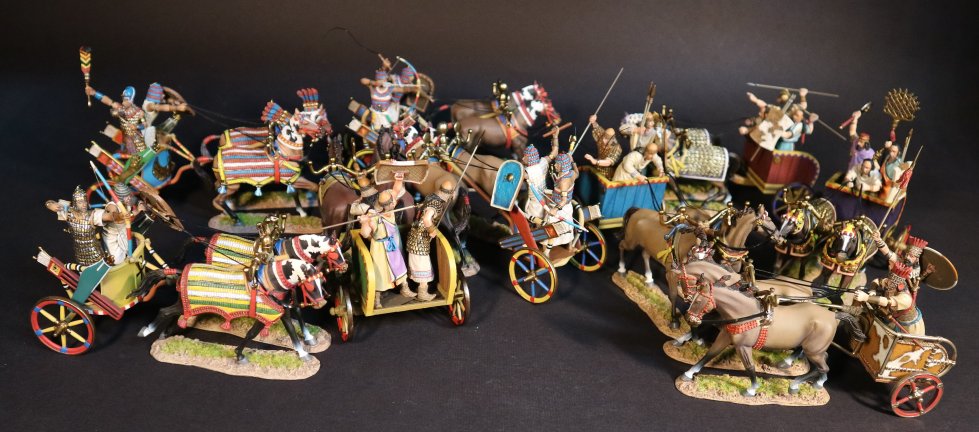
The Battle of Kadesh took place in the 13th century BC between the Egyptian Empire led by pharaoh Ramesses II and the Hittite Empire led by king Muwatalli II.
Their armies engaged each other at the Orontes river, just upstream of lake Homs and near the archaeological site of the fortified city of Kadesh.
It is generally dated to May 1274 BC, as accounted by Egyptian chronology, and is the earliest pitched battle in recorded history for which details of tactics and formations are known.
It is believed to be the largest battle ever fought involving chariots, numbering a total of around 6,000.
Kadesh remains a popular battle with historians because of the detailed pictorial representations left by Rameses II on the walls of temples at Thebes, Karnak, Luxor, Agydos and Abu Simbel.
As Rameses army marched up from the south, the Hittite king Muwatallis II, launched his attack by dispatching 2,500 chariots in four bodies across the Orontes via a ford just below the fortified city of Kadesh.
The Egyptian records describe how these chariots cut through the army of Ra in its middle, while they were marching without knowing and without being drawn up for battle, which broke the army and caused panic. The fleeing army fell into confusion against the army of Amun the second Egyptian army to the north, which also fell into confusion and flight.
The Hittites followed up this initial attack and finally encircled the Egyptian camp. Rameses’ personal leadership and tactical dexterity in the swirling chariot battle saved him at the decisive moment, and he was able to snatch victory from the jaws of defeat.
The outcome of the Battle of Kadesh is uncertain, although the timely arrival of Egyptian reinforcements prevented a total Hittite victory, the Egyptians did force the Hittites to take refuge in the fortress city of Kadesh, but their own losses prevented them from sustaining a siege.
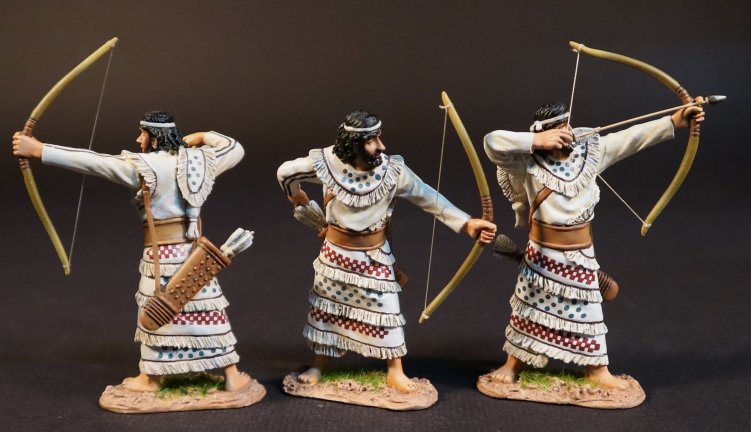
HITT-20N
THE ANCIENTS,
THE HITTITE EMPIRE,
THE BATTLE OF KADESH 1274BC,
SYRIAN MERCENARY ARCHERS
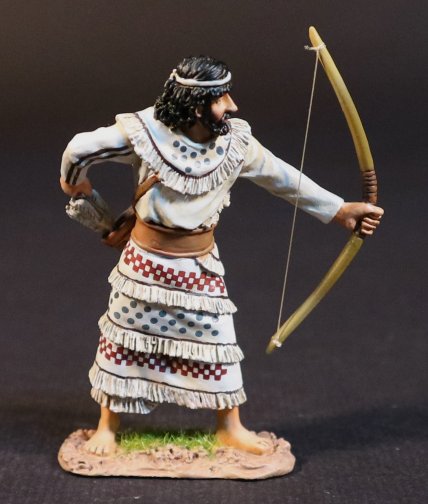
HITT-20A
THE ANCIENTS,
THE HITTITE EMPIRE,
THE BATTLE OF KADESH 1274BC,
SYRIAN MERCENARY ARCHER
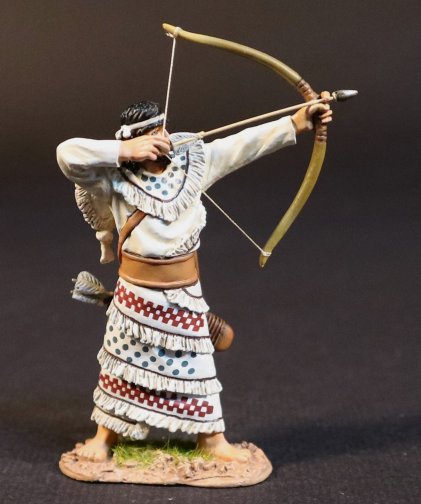
HITT-20B
THE ANCIENTS,
THE HITTITE EMPIRE,
THE BATTLE OF KADESH 1274BC,
SYRIAN MERCENARY ARCHER
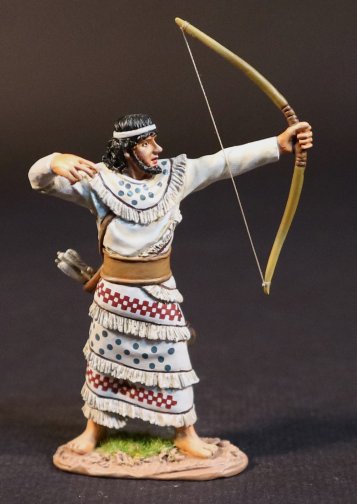
HITT-20C
THE ANCIENTS,
THE HITTITE EMPIRE,
THE BATTLE OF KADESH 1274BC,
SYRIAN MERCENARY ARCHER
ARMIES AND ENEMIES OF GREECE AND MACEDONIA
THE ACHAEMENID PERSIAN ARMY
KARDAKE INFANTRY
Kardakes translated means “foreign mercenaries”.
The Kardakes are a part of the Persian army that also appears towards the later empire, it is uncertain what they really were. Some say that they were mercenaries, others that they were influenced by the
Greek Hoplites and that we should assume that they were a Persian attempt to reform the army in a Greek way.

The Kardakes are described by historians as "Hoplites", Slingers and "Peltasts". This may illustrate that Kardakes most likely were not a specific troop type, like a heavy infantryman or a skirmisher but rather a specific group which supplied several kinds of soldiers.
This means that the Kardakes would have been equipped differently. At the battle of Issus Arrian calls them Hoplites, and Kallisthenes as Peltasts.
KARDAKE LIGHT INFANTRY
There has always been some debate over the armament and how the Kardakes were employed as a fighting force. As previously mentioned several historians have described them as peltasts.
Modern scholars seem to deduce from this that there was an attempt to produce a native Persian close fighting infantry to support the mercenary Greek hoplite, and Kardakes Hoplites, against the Macedonian phalanx.
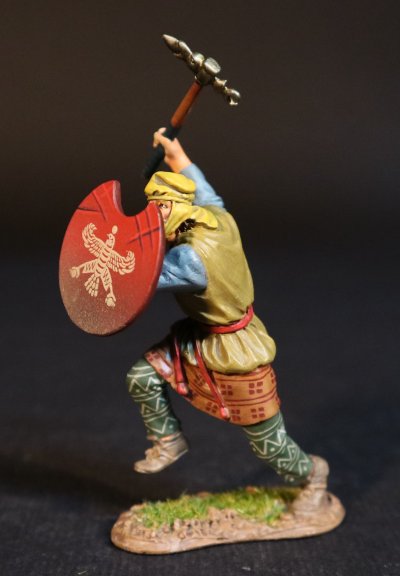
AP-25A
ARMIES AND ENEMIES OF ANCIENT GREECE AND MACEDONIA,
THE ACHAEMENID PERSIAN ARMY,
KARDAKE LIGHT INFANTRY
Xenophon describes the Kardakes as carrying two javelins, and using a Kopis or a Sagaris ( the bronze pick-like Saka battleaxe, which was adopted by the Persians) and a wicker shield. It is also confirmed that many would also have used bows.
The Alexander sarcophagus shows Persian infantry not only carrying Hoplite shields, but many with crescent shaped shields similar to the Greek peltai.

AP-25B
ARMIES AND ENEMIES OF ANCIENT GREECE AND MACEDONIA,
THE ACHAEMENID PERSIAN ARMY,
KARDAKE LIGHT INFANTRY
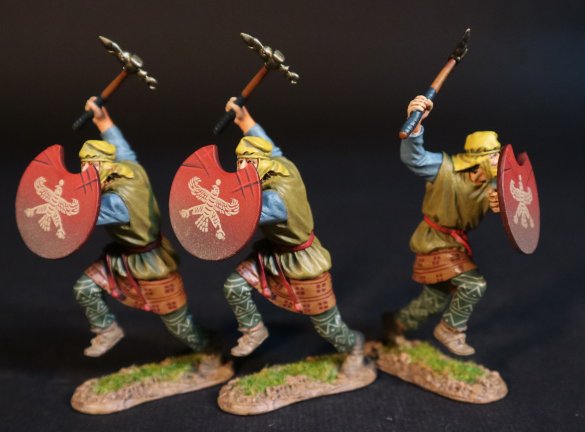
AP-25AN
ARMIES AND ENEMIES OF ANCIENT GREECE AND MACEDONIA,
THE ACHAEMENID PERSIAN ARMY,
KARDAKE LIGHT INFANTRY

AP-25BN
ARMIES AND ENEMIES OF ANCIENT GREECE AND MACEDONIA,
THE ACHAEMENID PERSIAN ARMY,
KARDAKE LIGHT INFANTRY
ARMIES AND ENEMIES OF ANCIENT ROME
THE CARTHAGINIANS
CELTIBERIAN SCUTARIUS
Although initially the Carthaginian army was composed only of Citizens of Phoenician origin, it saw increased recruitment of contingents of mercenaries and allies a necessity in order to realize the policy of imperial expansion.
This use of mercenaries saved the metropolitan population from heavy casualties that were not easily replaceable, and it also reflected the Carthaginian concept of war, which was considered simply as an extension of business.
With the enlargement of Punic economic interests the army became more exclusively mercenary and progressively came to include almost all the peoples of the central and western Mediterranean area.
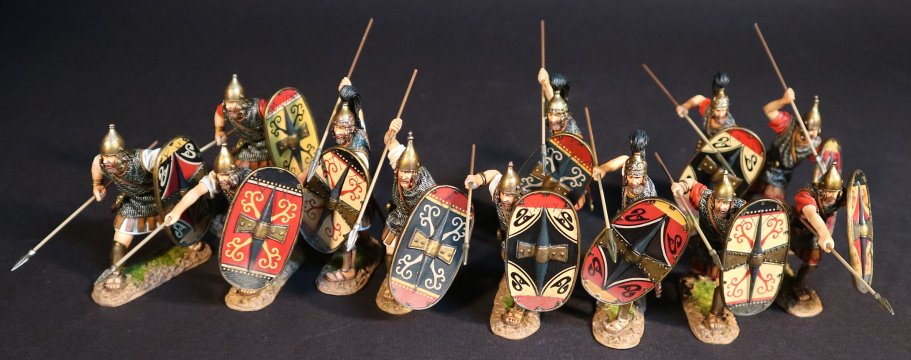
The success of Carthage in bringing most of central and southern Iberia under its control was a crucial element in their continued ability to pursue the war against Rome.
Iberian troops probably fell into two rough classifications, the Scutarii and the Caetratii.
These types basically defined the type of shield, with the Scutum being a large flat oval shield with a wooden spine and metal boss.
The Caetra was a flat, smaller round shield with a circular metal boss.
Both troop types were armed with a dagger and sword, as well as spears for hand to hand fighting and for throwing.

CTIB-06A
ARMIES AND ENEMIES OF ANCIENT ROME,
THE CARTHAGINIANS,
CELTIBARIAN SCUTARII
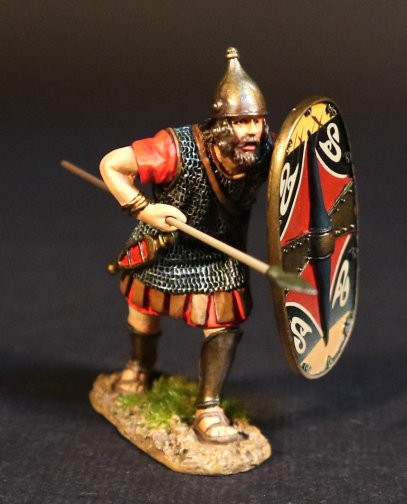
CTIB-06B
ARMIES AND ENEMIES OF ANCIENT ROME,
THE CARTHAGINIANS,
CELTIBARIAN SCUTARII
The Scutarius were well armoured heavy infantry, and the Celtibarians were mainly from the north, and were heavily influenced by their Gallic neighbours. Those who fought with Hannibal would have been mercenaries, and in organization and military effectiveness would have been much the same as the Gauls. They were known to be fierce, independent and dangerous.
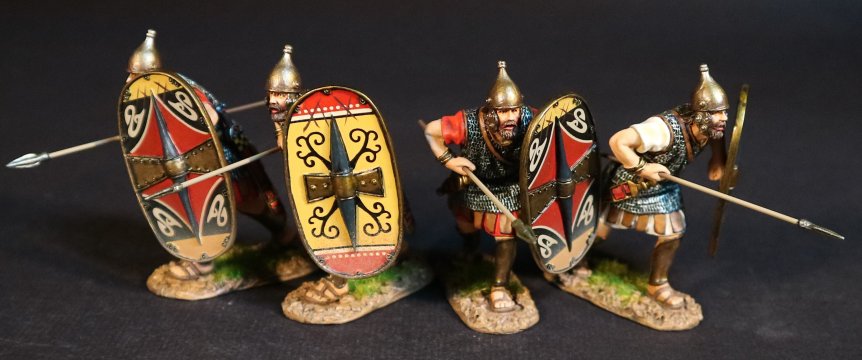
CTIB-06N
ARMIES AND ENEMIES OF ANCIENT ROME,
THE CARTHAGINIANS,
CELTIBARIAN SCUTARIUS
THE ANCIENTS
ARMIES AND ENEMIES OF THE NEW KINGDOM EGYPTIANS
THE BATTLE OF KADESH, 1274BC,
THE HITTITE EMPIRE.
Between the 15th and 13th centuries BC, the Hittites were one of the dominant powers of the near east, and clashed with the other main three powers, Egypt, the middle Assyrians and the empire of Mitanni.
The Hittite prosperity was mostly dependent on control of the trade routes and natural metal resources.
Because of the importance of northern Syria to the vital routes linking the Cilician gates with Mesopotamia, defense of this area was crucial, and was challenged by the Egyptian expansion under Pharaoh Ramesses II.

The Battle of Kadesh took place in the 13th century BC between the Egyptian Empire led by pharaoh Ramesses II and the Hittite Empire led by king Muwatalli II.
Their armies engaged each other at the Orontes river, just upstream of lake Homs and near the archaeological site of the fortified city of Kadesh.
It is generally dated to May 1274 BC, as accounted by Egyptian chronology, and is the earliest pitched battle in recorded history for which details of tactics and formations are known.
It is believed to be the largest battle ever fought involving chariots, numbering a total of around 6,000.
Kadesh remains a popular battle with historians because of the detailed pictorial representations left by Rameses II on the walls of temples at Thebes, Karnak, Luxor, Agydos and Abu Simbel.
As Rameses army marched up from the south, the Hittite king Muwatallis II, launched his attack by dispatching 2,500 chariots in four bodies across the Orontes via a ford just below the fortified city of Kadesh.
The Egyptian records describe how these chariots cut through the army of Ra in its middle, while they were marching without knowing and without being drawn up for battle, which broke the army and caused panic. The fleeing army fell into confusion against the army of Amun the second Egyptian army to the north, which also fell into confusion and flight.
The Hittites followed up this initial attack and finally encircled the Egyptian camp. Rameses’ personal leadership and tactical dexterity in the swirling chariot battle saved him at the decisive moment, and he was able to snatch victory from the jaws of defeat.
The outcome of the Battle of Kadesh is uncertain, although the timely arrival of Egyptian reinforcements prevented a total Hittite victory, the Egyptians did force the Hittites to take refuge in the fortress city of Kadesh, but their own losses prevented them from sustaining a siege.

HITT-20N
THE ANCIENTS,
THE HITTITE EMPIRE,
THE BATTLE OF KADESH 1274BC,
SYRIAN MERCENARY ARCHERS

HITT-20A
THE ANCIENTS,
THE HITTITE EMPIRE,
THE BATTLE OF KADESH 1274BC,
SYRIAN MERCENARY ARCHER

HITT-20B
THE ANCIENTS,
THE HITTITE EMPIRE,
THE BATTLE OF KADESH 1274BC,
SYRIAN MERCENARY ARCHER

HITT-20C
THE ANCIENTS,
THE HITTITE EMPIRE,
THE BATTLE OF KADESH 1274BC,
SYRIAN MERCENARY ARCHER
ARMIES AND ENEMIES OF GREECE AND MACEDONIA
THE ACHAEMENID PERSIAN ARMY
KARDAKE INFANTRY
Kardakes translated means “foreign mercenaries”.
The Kardakes are a part of the Persian army that also appears towards the later empire, it is uncertain what they really were. Some say that they were mercenaries, others that they were influenced by the
Greek Hoplites and that we should assume that they were a Persian attempt to reform the army in a Greek way.

The Kardakes are described by historians as "Hoplites", Slingers and "Peltasts". This may illustrate that Kardakes most likely were not a specific troop type, like a heavy infantryman or a skirmisher but rather a specific group which supplied several kinds of soldiers.
This means that the Kardakes would have been equipped differently. At the battle of Issus Arrian calls them Hoplites, and Kallisthenes as Peltasts.
KARDAKE LIGHT INFANTRY
There has always been some debate over the armament and how the Kardakes were employed as a fighting force. As previously mentioned several historians have described them as peltasts.
Modern scholars seem to deduce from this that there was an attempt to produce a native Persian close fighting infantry to support the mercenary Greek hoplite, and Kardakes Hoplites, against the Macedonian phalanx.

AP-25A
ARMIES AND ENEMIES OF ANCIENT GREECE AND MACEDONIA,
THE ACHAEMENID PERSIAN ARMY,
KARDAKE LIGHT INFANTRY
Xenophon describes the Kardakes as carrying two javelins, and using a Kopis or a Sagaris ( the bronze pick-like Saka battleaxe, which was adopted by the Persians) and a wicker shield. It is also confirmed that many would also have used bows.
The Alexander sarcophagus shows Persian infantry not only carrying Hoplite shields, but many with crescent shaped shields similar to the Greek peltai.

AP-25B
ARMIES AND ENEMIES OF ANCIENT GREECE AND MACEDONIA,
THE ACHAEMENID PERSIAN ARMY,
KARDAKE LIGHT INFANTRY

AP-25AN
ARMIES AND ENEMIES OF ANCIENT GREECE AND MACEDONIA,
THE ACHAEMENID PERSIAN ARMY,
KARDAKE LIGHT INFANTRY

AP-25BN
ARMIES AND ENEMIES OF ANCIENT GREECE AND MACEDONIA,
THE ACHAEMENID PERSIAN ARMY,
KARDAKE LIGHT INFANTRY
ARMIES AND ENEMIES OF ANCIENT ROME
THE CARTHAGINIANS
CELTIBERIAN SCUTARIUS
Although initially the Carthaginian army was composed only of Citizens of Phoenician origin, it saw increased recruitment of contingents of mercenaries and allies a necessity in order to realize the policy of imperial expansion.
This use of mercenaries saved the metropolitan population from heavy casualties that were not easily replaceable, and it also reflected the Carthaginian concept of war, which was considered simply as an extension of business.
With the enlargement of Punic economic interests the army became more exclusively mercenary and progressively came to include almost all the peoples of the central and western Mediterranean area.

The success of Carthage in bringing most of central and southern Iberia under its control was a crucial element in their continued ability to pursue the war against Rome.
Iberian troops probably fell into two rough classifications, the Scutarii and the Caetratii.
These types basically defined the type of shield, with the Scutum being a large flat oval shield with a wooden spine and metal boss.
The Caetra was a flat, smaller round shield with a circular metal boss.
Both troop types were armed with a dagger and sword, as well as spears for hand to hand fighting and for throwing.

CTIB-06A
ARMIES AND ENEMIES OF ANCIENT ROME,
THE CARTHAGINIANS,
CELTIBARIAN SCUTARII

CTIB-06B
ARMIES AND ENEMIES OF ANCIENT ROME,
THE CARTHAGINIANS,
CELTIBARIAN SCUTARII
The Scutarius were well armoured heavy infantry, and the Celtibarians were mainly from the north, and were heavily influenced by their Gallic neighbours. Those who fought with Hannibal would have been mercenaries, and in organization and military effectiveness would have been much the same as the Gauls. They were known to be fierce, independent and dangerous.

CTIB-06N
ARMIES AND ENEMIES OF ANCIENT ROME,
THE CARTHAGINIANS,
CELTIBARIAN SCUTARIUS

